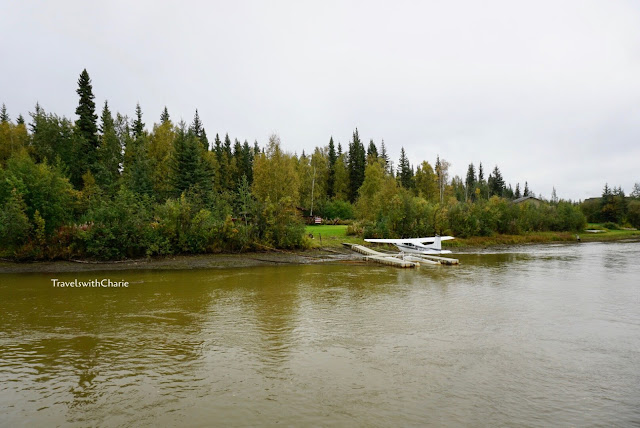Sternwheeler Riverboat
This three-hour leisurely cruise on the Chena River was one of the best experiences I had in Fairbanks. As our riverboat slowly made its way to the confluence with the Tanana River, I witnessed how life on the river evolved from the subsistence lifestyle of the nomadic Athabascan Indians to the arrival of riverboats that brought the villagers their supplies and correspondence which was replaced by sled dogs during the winter months when the river was frozen to the red-hot housing market by the Chena River today. There’s much to learn as the 100-mile long Chena River continues its journey through time and place.
A bush pilot expertly lands his float plane on the Chena River. Bush pilots deliver supplies to remote villages and are also used for tourism purposes.
At the Trail Breaker Kennel and home of the late Iditarod four-time champion, Susan Butcher, we had the chance to see a dog mushing demonstration and get up close with some of the huskies at the Athabascan Indian village.
President Ronald Reagan stayed overnight here on his way back to the White House from a meeting in China. This was then the house of former Senator Frank Murkowski. The Pope was also on stopover in Fairbanks on his way to South Korea so they had the opportunity to meet at the Fairbanks International Airport.
We got off at the Chena Indian Village Living Museum and learned all about the culture and traditions of the Athabascan Indians who have lived in Interior Alaska for thousands of years. Photo shown above is one of several log cabins with a sod roof which can be found in the village. For more insight into the Athabascan way of life, follow this link: https://www.travelswithcharie.com/2021/09/athabaskan-indian-village-life.html
Deer roam the banks of the Chena River at the Athabascan Indian Village.
The 584-mile long Tanana River is a tributary of the Yukon River. Here’s where the Tanana and Chena rivers meet.
The fabulous riverfront homes along the banks of the Chena River
As we cruised slowly on the Chena River, I noticed that there were many big homes along the banks of the river. It seems that this is where the affluent of Fairbanks reside or at least have a summer home. There are a few log cabins but most of the houses have a modern design aesthetic with large windows to capture the light which is absent during the long winter months.
Excerpt from The Brook by Alfred Lord Tennyson
I chatter, chatter as I flow
To join the brimming river
For men may come and men may go
But I go on forever.
Check this link for more information about the sternwheeler river cruise:
Images by TravelswithCharie











